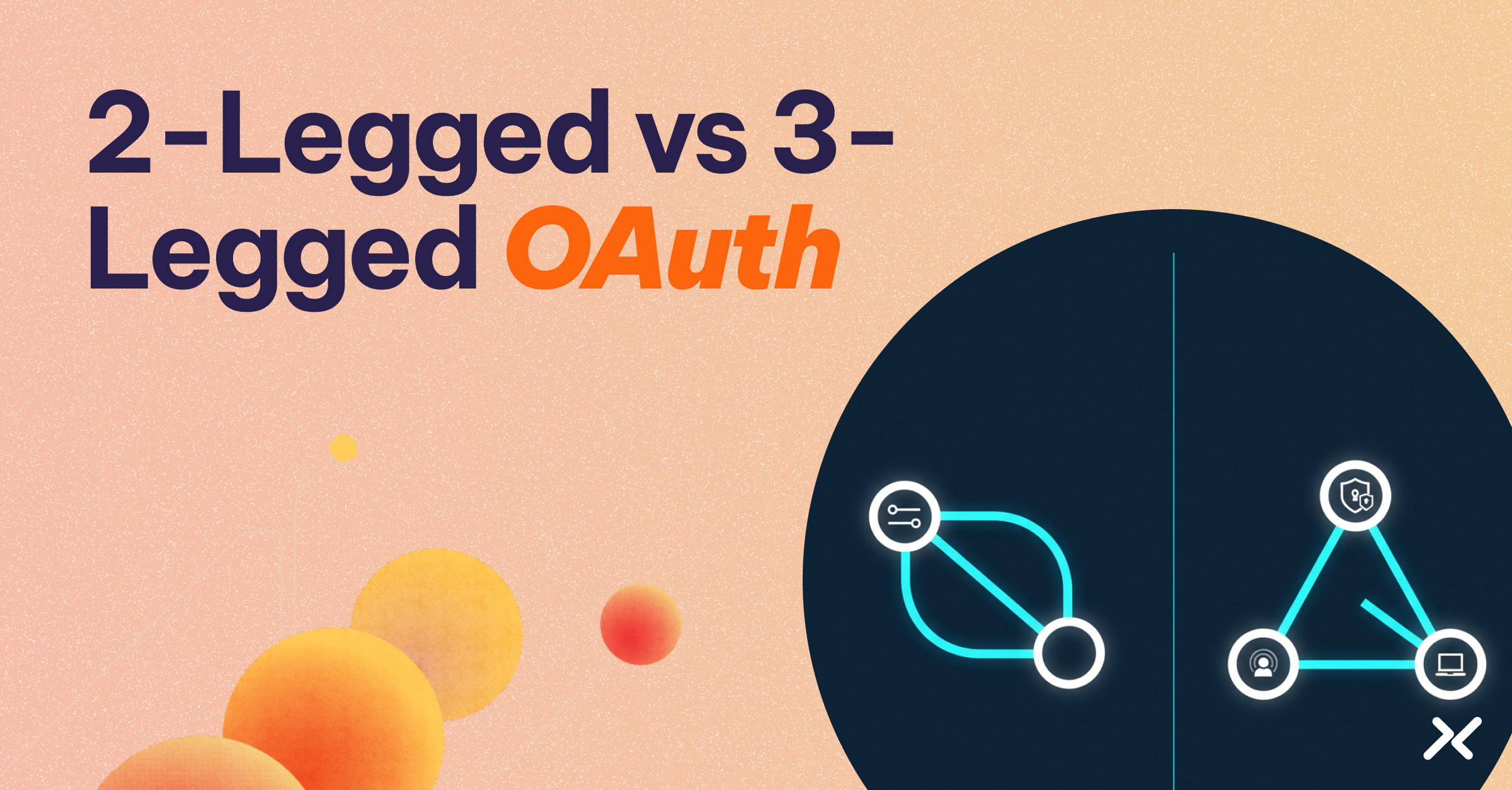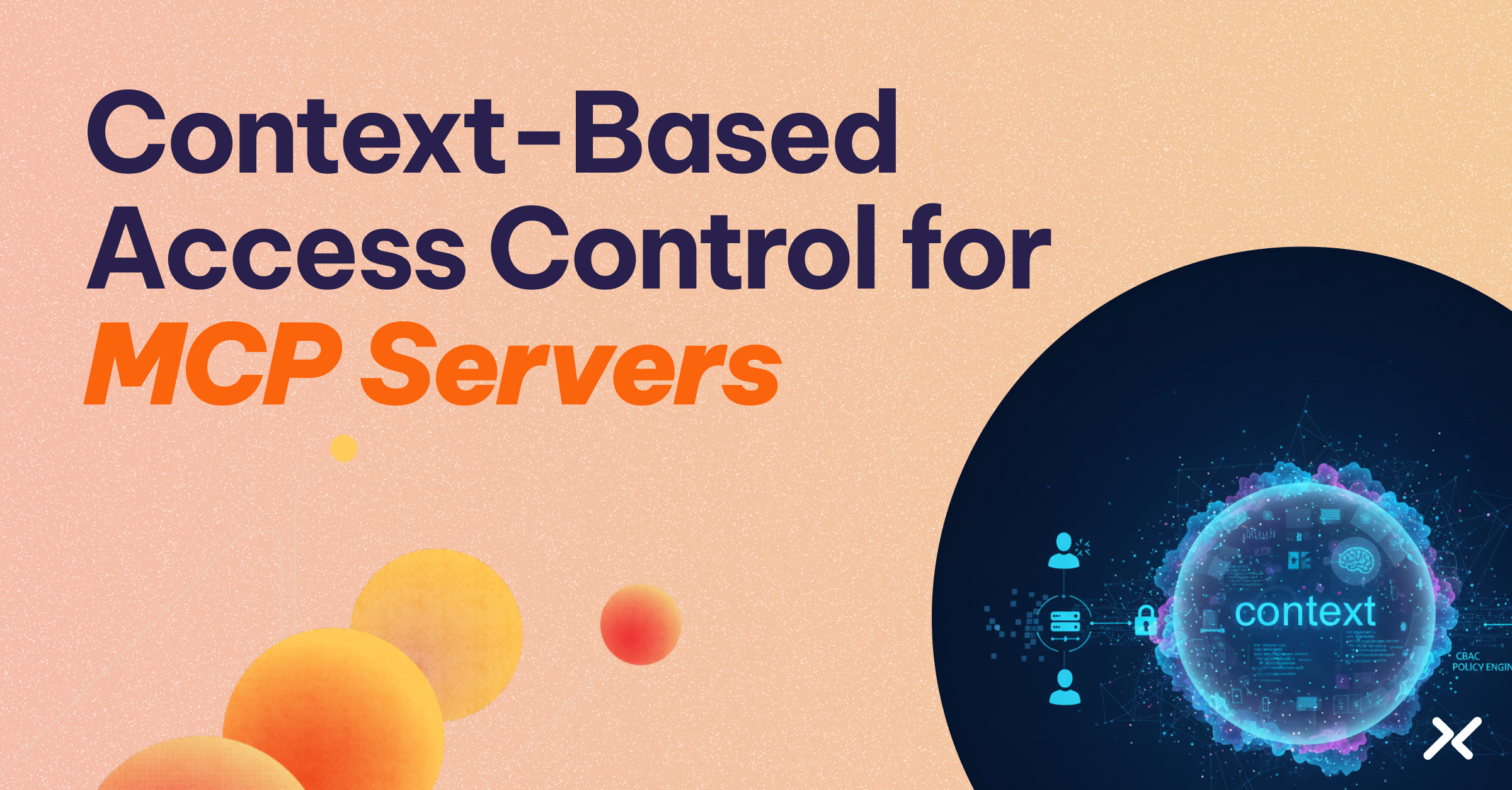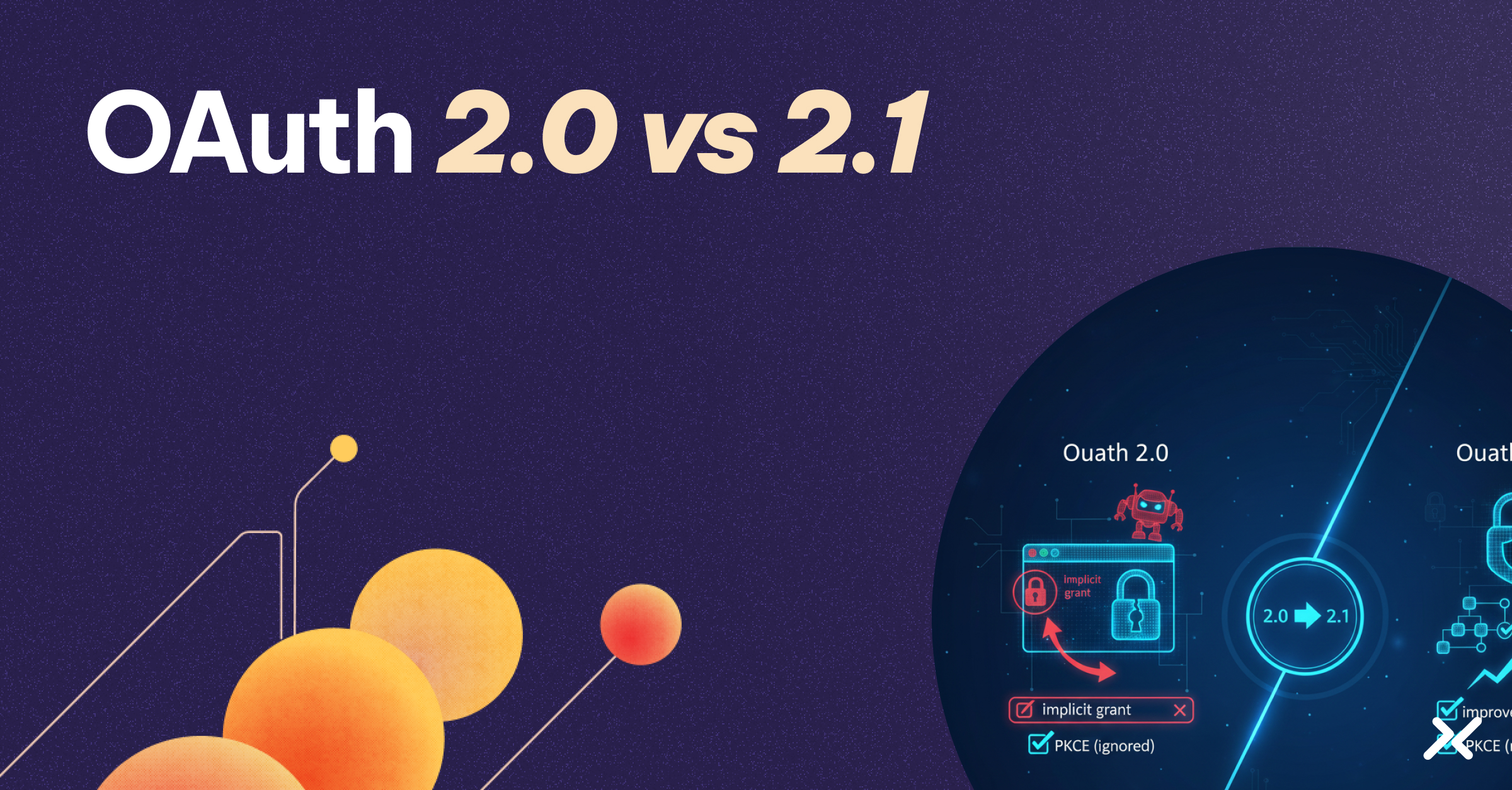The difference between 2-legged and 3-legged OAuth comes down to who authorizes access.
If a user needs to approve what your service does, use 3-legged OAuth. If your service acts independently, use 2-legged OAuth. That’s the core decision, but choosing the right flow is only the beginning. The real challenge is implementing either flow without creating persistent credential vulnerabilities that undermine your security.
This article shows you when each flow applies, what security risks you’re accepting, and how modern secretless patterns eliminate those risks entirely.
How Each OAuth Flow Actually Works
The protocol-level differences between these flows reveal why they solve completely different problems.
2-legged OAuth (Client Credentials Flow) involves your service authenticating directly to an authorization server using a client_id and client_secret. The server responds with a token representing your service’s own authority, not a user’s permission.
Two parties establish trust: your client and the authorization server. These tokens typically last hours to days since there’s no user to re-authenticate.
3-legged OAuth (Authorization Code Flow) adds a resource owner (the user) to the equation. Your service redirects the user to an authorization server where they explicitly grant or deny specific permissions. The user’s approval generates an authorization code, which your service exchanges for a token representing the user’s delegated permission.
This creates three parties: your client, the authorization server, and the resource owner.
Access tokens should expire in minutes, with refresh tokens extending the session.
Mobile and single-page apps must use PKCE (Proof Key for Code Exchange) to prevent authorization code interception. PKCE requires the client to generate a random code verifier and send a hashed version during authorization.
When exchanging the authorization code for tokens, the client must provide the original verifier, proving that whoever started the flow is the same entity completing it.
The architectural difference matters because it determines your entire authentication approach. In 2-legged flows, your service carries its own authority. In 3-legged flows, your service acts on behalf of users who can revoke access at any time.
When to Choose Each Flow
Ask yourself one question: “Is there a resource owner separate from my client who needs to approve this access?”
If yes, use 3-legged OAuth. The user controls what your service can access and can revoke those permissions whenever they want.
If no, use 2-legged OAuth. Your service acts with pre-configured permissions and no user is present to grant approval.
Choose 2-legged OAuth when your service authenticates to another service without user involvement. Background processes, daemon services, CI/CD pipelines deploying code, and serverless functions querying databases all operate independently. A Kubernetes microservice querying an internal payment API doesn’t have a user present to grant permission. It needs to authenticate based on its own identity.
Choose 3-legged OAuth when third-party applications need access to user data in another service. Users logging in with social accounts, mobile apps reading files or calendars, or any consumer-facing app where users control access requires explicit user authorization. Your mobile app reading a user’s Google Drive must get the user to explicitly authorize which files you can access.
Here’s a simple decision framework:
Does a user need to approve access to their data?
├─ YES → 3-legged OAuth (Authorization Code Flow)
│ └─ Mobile/SPA? → Add PKCE
└─ NO → Is this service-to-service?
├─ YES → 2-legged OAuth (Client Credentials)
│ └─ Can you eliminate secrets? → Workload Identity Federation
└─ NO → Reconsider your architecture
The distinction becomes obvious when you think about control and revocation. With 3-legged OAuth, users can revoke your app’s access at any time through their account settings. With 2-legged OAuth, access depends on pre-configured service credentials that only administrators can modify.
Security Threats and Defense Strategies
Each flow introduces specific vulnerabilities requiring different defensive strategies.
Securing 2-Legged Implementations
Static client secrets create persistent attack vectors. Hardcoded credentials in code, Git commits, and environment variables have led to real breaches at Uber, CircleCI, and GitHub.
The “secret zero” problem asks: how does your service get its initial credentials without storing them? Even when using secrets managers like HashiCorp Vault, your service needs an initial secret to authenticate to the vault. You’ve just moved the problem, not solved it. True secretless authentication eliminates this recursive dependency by deriving trust from cryptographically verifiable environment attributes instead of stored credentials.
Organizations managing hundreds of microservices face exponential credential sprawl. Each service potentially needs credentials for 5-10 external dependencies, creating thousands of secrets requiring rotation. Manual rotation cycles that take weeks leave a window where compromised credentials remain valid.
Workload Identity Federation eliminates long-lived static credentials for workload authentication through environment-based attestation. Instead of storing a client_secret, your service proves its identity by demonstrating it’s running in a trusted environment using cryptographic proof from cloud providers or Kubernetes clusters.
Securing 3-Legged Implementations
PKCE prevents authorization code interception during redirects. Attackers who steal authorization codes during the redirect flow can’t use them without the code verifier that only the legitimate client possesses.
Stolen access tokens from client storage let attackers impersonate users. Store tokens securely in appropriate locations (httpOnly cookies for web apps, secure storage for mobile), use short token lifespans (15-60 minutes), and implement refresh token rotation.
CSRF attacks trick users into authorizing an attacker’s account by manipulating the redirect flow. For instance, an attacker tricks a victim into authorizing the attacker’s Spotify account to connect to the victim’s Facebook. Now the attacker’s Spotify shows the victim’s listening history. Validate the state parameter on every callback to ensure the authorization response matches your original request.
Universal Security Principles
Whether you’re implementing 2-legged or 3-legged flows, always verify JWT signatures, transmit tokens only over TLS, implement comprehensive audit logging, and scope tokens to the minimum permissions required.
Real-World Implementation Patterns
OAuth flows integrate differently depending on your architecture and operational requirements. Here’s how to apply the right flow in three common scenarios.
CI/CD Pipeline to Cloud Provider (2-legged): Traditional GitHub Actions workflows stored AWS credentials in GitHub secrets, creating rotation burdens and exposure risks. Modern implementations use workload identity federation via OIDC tokens to eliminate stored credentials entirely. GitHub issues a signed identity token to your workflow, which exchanges it for temporary AWS credentials without any static keys—now GitHub’s recommended approach for cloud deployments.
SaaS App to User’s Calendar (3-legged): A project management tool accessing Google Calendar requires user consent. The authorization code flow presents users with a clear permission request showing exactly what data your app wants to access. Users explicitly grant or deny permission and can revoke access anytime through their Google account settings.
Microservice to Database (2-legged): Traditional payment services stored static database credentials requiring manual rotation. Modern approaches significantly reduce credential exposure: cloud-managed databases support workload identity federation for token-based authentication, while on-premises databases leverage workload identity platforms to generate short-lived, automatically-rotated passwords. The microservice authenticates using its workload identity and receives temporary credentials specific to its session, minimizing the window of exposure.
Advanced OAuth Patterns for Modern Workloads
As cloud-native architectures evolve, OAuth implementations have adapted to handle new challenges around automation, scale, and security.
OAuth 2.1 Consolidation makes PKCE mandatory for all clients and removes the implicit flow entirely, reducing the attack surface. These changes reflect years of real-world security experience and tighten the protocol against known vulnerabilities discovered in production deployments.
Workload Identity Federation enables cross-cloud authentication without credential duplication. GitHub Actions workflows can access GCP resources by exchanging GitHub-issued OIDC tokens for GCP access tokens, with no static service account keys required. This pattern extends across AWS, Azure, and third-party services, creating a unified authentication model across heterogeneous environments.
Conditional Access evaluates real-time context like workload posture, location, and time before granting credentials. This implements Zero Trust principles for workloads by requiring continuous verification rather than implicit trust. A service might be granted access only during business hours, from specific geographic regions, or when security scans confirm it’s running approved code.
Ephemeral Token Issuance provides just-in-time credentials that expire quickly, limiting the attack window compared to long-lived static credentials. Tokens that expire in minutes or hours mean that even if credentials are compromised, attackers have a limited window to exploit them.
AI Agent Authentication presents unique challenges as autonomous systems operate without users in the loop. Authentication standards like the Model Context Protocol extend OAuth 2.1 patterns to handle dynamic, non-human workloads that make runtime decisions about which APIs to access.
Selecting the Right OAuth Flow and Achieving Zero Trust
Choosing the right OAuth flow depends on who authorizes access. Use 3-legged OAuth for user-facing features requiring user consent. Use 2-legged OAuth for backend workloads acting independently.
Real security means eliminating persistent credentials entirely. Replace stored client_secrets with secretless patterns via environment attestation. Implement Workload Identity Federation for cross-cloud authentication. Add Conditional Access for real-time, context-aware policy decisions. Aembit reduces reliance on static client credentials by using cryptographically verified workload identity and just-in-time, scoped access. For systems that still require long-lived secrets, Aembit can securely store and inject them so workloads operate without directly managing credentials.




